

The manufacture of all Secondary Explosive Initiators has given RISI a unique capability to perform critical explosive and non-explosive powder operations. RISI can perform the operations shown below for any customer need.
RISI routinely recrystallizes PETN, RDX and HNS explosive for their own use in the manufacture of Exploding Foil Initiators and Exploding BridgeWire Detonators. We have also recrystallized HNAB and NONA explosives. This process is critical to the performance of RISI’s standard product line of EBW’s and EFI’s and has been performed since 1968 when the sale of EBW’s first started in a joint venture with Physics International. Processed PETN was used in an EBW for the Polaris Missile and later the Poseidon Missile under contract with the Lockheed Missile and Space Program. During this 29 year period the process has been continually improved to the point where EBW’s are now used in general blasting and mining applications or wherever added safety is needed.
RISI presently adds binder to both RDX and HNS in the manufacture of their standard product line of EBW and EFI detonators and other products. Binder materials including FPC461 and Kel-F-800 are now used in these Plastic Bonded Explosives. Other binders can also be used as required.
RISI has been manufacturing explosive pellets since 1968. All EBW’s and EFI’s require some type of high density pellet. These operations include: (1) Very precise hand weighed, single station die pressing. (2) Single station automatic press-ing (3) Multi station automatic pressing. RISI maintains a large selection of tooling diameters to fabricate pellets with various types of secondary explosives. RISI has had considerable experience precision loading explosives such as PETN, RDX, HNS, PBX-9407 and PBX-N5. Diameters as small as 0.062 inch and as large as 0.625 inch have been succesfully loaded to tolerances as low as plus or minus 0.1 milligram and densities as tight as 0.01 g / cc. RISI has the capability to control densities by either pressure loading or weighing and pressing to fixed stops.
RISI has a multiple CAD capability which greatly enhances electronic and mechanical design/drafting. The CAD system also assists in the control of documents and design configurations.
RISI’s explosive storage, pelleting, drying and processing operations located on-site in San Ramon are specifically designed and equipped to support the requirements of small and large volume explosive powder handling. A fully equipped electronic firing system development laboratory is maintained to develop and produce prototype quan-tities, special firing systems and associated test equipment.
A prototype model shop is maintained to fully support research and development programs. This facility enables rapid turnaround of metal and plastic parts to insure development schedules are met. The shop is also utilized to to produce soft tooling in advance of production.
Extensive ordnance testing facilities are maintained to meet the varied system applications and needs. Included is equipment to support nano-micro-and millisecond event timing reliability and safety parameter studies. Additionally, specialized environmental test equipment is available to test explosive devices at low pressure (altitude) and extreme temperature conditions.
Many of RISI’s products evolved from customer requirements. Some items never became products but were developed and tested. Others were built for concept demonstrations. This section of the catalog presents the general characteristics of several of these products. All of these products, or variations of these products, can be special ordered and
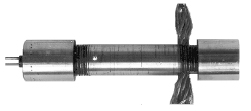
Features the safety and timing available from all secondary explosives. The cutter will shear up to a 3/8 inch diameter braided steel cable or Kevlar™ rope.
The explosive blast is completely contained within the cutter. The barrel, anvil and caps can be re-used.
The cutter requires standard RP-75 firing parameters.

This is a passive, single shot device to check if a system triggered with sufficient energy to function an EBW detonator by protrusion of a pin. This device contains a small quanity of PETN explosive which is totally contained in the unit when it functions.

For diaphragm rupture of up to 0.012 inch thick stainless steel. This actuator does not require any explosive. It can be designed also to cut wire or cable or function as a switch. Timing from 1.0 µs. Requires RP-1 firing parameters

These detonators are hermetically sealed and will meet leakage requirements of better than 1x10-6 cc He per second. The example shown has a high alumina ceramic insulator brazed to the stainless steel body and center contact. The tapered ceramic interface mates easily to a connector with a silicone rubber insulator which enables the detonator to function at any altitude.
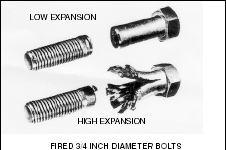
These bolts have the safety and timing of all secondary explosives. The minimum diameter is 0.5 inch with a tensile strength of 21,000 pounds. The bolts are fabricated from high strength alloy steel. When functioned, fracture occurs at a specified break line. Requires standard RP-2 firing parameters.
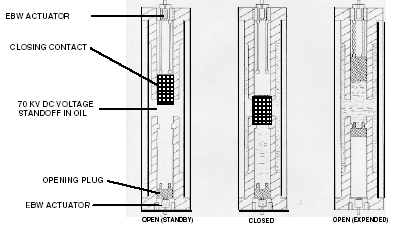
EBW explosive switches have the advantages of fast response times in the microsecond time frame and being able to hold off large current and voltages because of the energy densities available to perform work from the secondary explosives
Designs have been built and tested for 70 KV DC, 2,000 Amp systems with total system trip times of < 0.5 milliseconds.
Two concepts have been manufactured: (1) The movement of a mass to either open or close the switch, and (2) The use of a shaped charge to pierce or destroy the switch insulation.
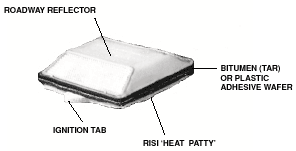
This material is designed to quickly heat and melt construction materials such as bitumen and some plastic adhesives for heat bonding. Low ash maximizes the bond strength.
The application shown is a roadway reflector using a heat patty for bonding to a roadway surface. Once the reflector is spotted in place, the ignition tab is lit using a hand held butane lighter. Burn time is less than 20 seconds.
Thermite powder is a mix of vaious metal powders and is generally used in the welding industry. These powders produce a very hot gas and shock output when ignited.
RISI has developed an initiator using Thermite Powder that has the same ignition characteristics as an EBW (see the SQ-80). These devices can be used to burn holes or grooves in diaphragms, ignite other materials or as an electric match with the safety and speed of an EBW.
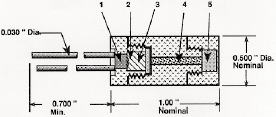
A detonator with similar current and voltage inputs as a Hot Wire, primary explosive detonator but using only secondary explosives such as PETN, RDX or HMX. The DDT has has an all fire current of 2.5 amps with a 1.0 0hm bridgewire. Nominal dimensions are 0.500 inch diameter by 1.0 inch.
This detonator can be designed to function from the following:
- A detonating explosive
- A deflagrating explosive
- A propellant
- An exploding wire
- A projectile with sufficient kinetic energy
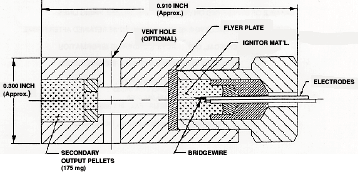 The concept of the Flying Plate Detonator provides a detonation output from mechanical, electrical and non-explosive inputs which in general are not normally used.
The concept of the Flying Plate Detonator provides a detonation output from mechanical, electrical and non-explosive inputs which in general are not normally used.
RISI will modify most products shown in the catalog to meet a customers special requirements. Depending on the extent and complexity of the change, a non-recurring tooling charge may be necessary. Delivery time may also be extended if the changes are extensive.
RISI also manufactures a number of products on special order for which tooling and detail component parts already exist. These products are not normally in stock because of low useage but can be assembled in a reasonable length of time for a special order. Examples of these kinds of units include the following:
RP-1 Coax Detonator - P/N 167-4315
Same as the RP-1 Pigtail Detonator except for an integral Type 31 coaxial connector.
RP-2 Coax Detonator - P/N 167-4378
Same as the RP-2 Pigtail Detonator except for an integral Type 600 coaxial connector.
RP-1 Boosted Detonator - P/N 167-9041
A canned RP-1 Detonator with a total explosive load of 4.35 grams.
RP-1 Sugar Load Detonator, Pigtail - P/N 167-4334
RP-1 Sugar Load Detonator, Coaxial - P/N 167-2716
Exact replicas of an RP-1 Detonator except for the substitution of sugar for the explosive materials. Used to better simulate the exploding bridgewire function by packing a low density powder (sugar) around the wire.
RP-86 Detonator - P/N 188-7074
A sealed detonator for underwater use with a 2 gram output charge. Used in seismic studies.
Pellets
RISI maintains tooling to fabricate pellets of various diameters for use with most secondary explosives.
RISI stocks detonator components such as heads (bridged or unbridged), pellets, sleeves and cans for all the common RISI detonators and are available for sale
RISI will also bridge customer furnished heads with either the standard gold bridgewire or a customer specified material or diameter. Used heads can also be rebridged provided they pass an incoming inspection.
|
Description |
Part Number
Bridged Heads |
Part Number
Unbridged Heads |
| RP-1 Pigtail | | |
| RP-1 Coax | | |
| RP-2 Pigtail | | |
| RP-2 Coax | | |
| RP-3 Pigtail | | |
| RP-80 Pigtail | | |
| RP-83 Pigtail | | |
| RP-87 Pigtail | | |
| RP-501 Pigtail | | |
click part number to add to quote request |
High Temperature RDX and HMX*** EBW Detonators- UPDATED 12/017/2014
RISI has developed a line of High Temperature EBW detonators for use in applications where temperatures exceed the limits of the PETN initial pressing used in standard EBW detonators. High Temperature EBW’s use:
RDX for temperature requirements MAX 302F/150C, 1 Hour, Note: Anodized Gold Cup
HMX for temperature requirements MAX 400F/205C, 1 Hour, Note: Anodized Red Cup
These detonators are available on special order. In order to reduce delivery time they have been designed around four of our standard EBW detonators and use common parts except for the Explosive. They are intended to be used with the PX-1 Expendable Firing Unit.
1.4B, UN0255 DOT Approval for shipment in a Fiberboard Box
 RP-800 RDX P/N 188-7330
RP-800 RDX P/N 188-7330
RP-8000 HMX P/N 188-7453Same dimensions as RP-80 |
 RP-830 RDX P/N 188-7342
RP-830 RDX P/N 188-7342
RP-8300 HMX P/N 188-7455Same dimensions as RP-83 |
 RP-810 RDX P/N 188-7409
RP-810 RDX P/N 188-7409
RP-8100 HMX P/N 188-7454
Same dimensions as RP-81 |

RP-880 RDX P/N 188-7354
RP-8800 HMX P/N 188-7456
Same dimensions as RP-880
|
 RP-750 P/N 188-7392
RP-750 P/N 188-7392
High Temperature RDX EBW Detonator
Same dimensions as RP-75 |

P/N 188-7390
The RP-75 is a sealed EBW detonator with an integral connector for underwater use. All RP-75 detonators are individually tested to 1000 psi water pressure.

RP-75 Firing Parameters |
| Threshold Burst Current: | 180 amps |
| Threshold Voltage: | Approx. 500 volts |
| Threshold Voltage Std. Deviation: | 50 volts maximum |
| Function Time: | 7.5 µsec. typical |
Function Time Simultaneity
Standard Deviation: | 0.125 µsec Max. |
|
Caution: While EBW and EFI Initiators are inherently less susceptible to accidental detonation during handling and set-up than devices containing primary explosives, electrical and electronic firing systems are sensitive to transient electrical energies which could cause premature triggering or firing. The blasting area must be clear of personnel and equipment before the detonator leads are connected to any RISI Firing System. Only approved RISI Firing Systems should ever be |
